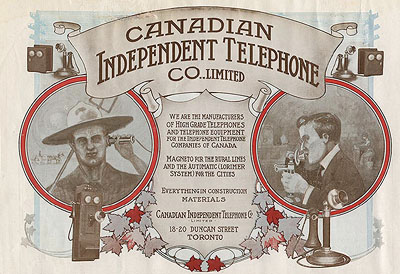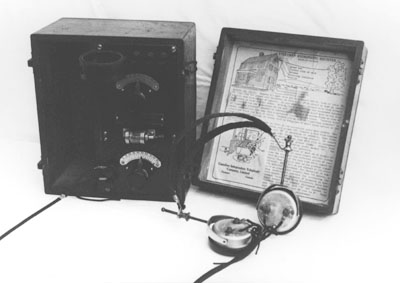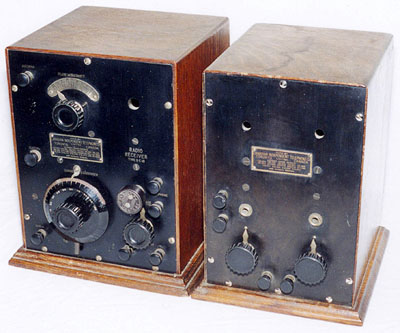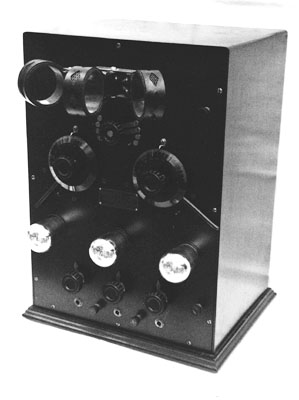Of Old Radios And Related Items--Published Monthly
Radios of the Canadian Independent Telephone Co., Limited
BY ROBERT P. MURRAY AND HERB K. FREDERICKSON
Web edition
In the following article, the Canadian team of Murray and Frederickson trace the history of a small independent telephone company of the 1920s. How the brief career of this company as a maker of radios interacted with the De Forest Company makes interesting reading for collectors who focus on sets of the 1920s. (Editor)In Canada at the beginning of the 20th century, the Bell Telephone Company was expanding rapidly, but was concentrating first on the more heavily populated areas. To fill the need in rural areas, small independent companies were started, often by local doctors. By 1921, there were around 680 non-Bell companies in the province of Ontario alone.
The Canadian Independent Telephone Co., Limited, (CITCo), founded by William A. Woods, a Hamilton businessman, was incorporated to manufacture and supply equipment to these small telephone operations. An example of a company ad, which appeared in rural publications, is shown in Figure 1.
Figure 1. A rural magazine ad for the Canadian Independent Telephone Co. telephone equipment.
Originally located at 18-20 Duncan Street in Toronto, the company later moved to larger premises on Adelaide Street, also in Toronto. Occupying the same premises was the Canadian Machine Telephone Co., a manufacturer of automatic telephone switchboards and dial telephones. The two companies shared both facilities and employees, and in 1920, formed a subsidiary company, the Canadian Radio Corporation, Ltd. This latter company acquired licenses and patent rights to manufacture radio equipment, including Canadian rights to the patents of Lee de Forest. It did not, as far as we know, manufacture anything.CITCo owned and operated its own radio station in Toronto, a marketing strategy that was common at the time. It was listed in Canadian radio magazines as station CKCE, operating on 450 meters. This station listing appeared from July 1922 until May 1924, athough the hours of operation were not recorded for posterity.
The Radio Sets
The Canadian Independent Telephone Co. began manufacturing a line of De Forest radio receivers in 1923, which were sold under the CITCo label. The Everyman crystal set was a close copy of the De Forest set, including the instruction sheet glued to the inside of the lid, as shown in Figure 2.
Figure 2. Everyman Radiophone Receiver.
The company also produced a 1-tube regenerative set, the SC-10, and a matching 2-tube amplifier, the Model S, as shown in Figures 3 and 4 (see print version). The detector and the amplifier are housed in two sturdy oak boxes.The detector unit is 8" x 11" x 8" deep (excluding the bottom molding); the amplifier unit is 7" x 11" x 8" deep.
Figure 3. Front view of the SC-10 receiver and the Type S amplifier.
In the SC-10 detector, the tuning condenser is located in series between the antenna and the antenna coils. There is a "loading" switch that adds another coil to increase the band coverage. The phone jack is located in the B- line -- an unusual location.In 1923, these sets were advertised in the Canadian radio magazine Radio as the receiver used by British Prime Minister Lloyd George when he made his way across Canada by train. Royalist sentiment was popular in Canada at the time.
The pinnacle of this series of sets influenced by De Forest was the "Universal Receiving Set," a 3-tube set with the tubes and coils protruding from the vertical front panel, as shown in Figures 5 and 6 (see print version). The dimensions are an impressive 12" x 18" x 10" deep, with coils and three 201-A tubes mounted on the front panel.
Figure 5. Front view of the Universal Receiving Set.
This is also a regenerative set, supplied with Philips Type 201-A tubes made in Holland for the North American market. The interior of the set has Fahnestock clips for the B battery connections, and a wooden battery shelf slides into grooves in the base. The Fahnestock clips are labeled with paper tags inscribed by hand in ink, and hanging on loops of fine string. The A battery terminals are accessible on the front panel.In addition to receivers, in 1923-24, the Canadian Independent Telephone Co. advertised a horn speaker, as shown in Figure 7 (see print version). It appears to be conventional in design, although it is rarer now than the receivers, and we have never seen one. The company also made its own headphones, shown in Figure 2, which are similar in appearance to Brandes phones, but are marked with both resistance (R = 2000 ohms) and impedence (Z = 12500 ohms).
The Last Days
The Canadian Independent Telephone Co. group of companies was experiencing financial difficulties in 1923, and the Canadian Machine Telephone Company filed for bankruptcy on December 28, 1923. Its rural telephone systems were placed under receivership and were eventually taken over by the Canadian Bell system in 1925. On February 2, 1924, a trustee was appointed over the Canadian Independent Telephone Co.
The last advertisements for CITCo products appeared early in 1924, suggesting that the company lasted as a manufacturer of broadcast receivers for about a year. It appears that the three receivers described in this article were the only models made. The Everyman crystal set was advertised by Canada West Electric, Limited, in Regina, Saskatchewan (Exclusive Distributors) for $26.
After CITCo went out of business, the Everyman crystal set was advertised in the fall and winter 1925-1926 Eaton's radio catalog for $2.45, and again in the spring and summer 1926 catalog. The last listing by Eaton's for the crystal set was in its fall 1926 catalog and spring and summer 1927 catalogs at $1.95. However, on the cover of Eaton's radio catalog for 1930, there is a sketch of a Universal Receiving Set with three Myers RAC-3 tubes mounted on the panel.
Since the Canadian Independent Telephone Co. was one of the first manufacturers of domestic radio receivers in Canada, it attracted the attention of young men seeking a career in radio work. One of these was Ted Rogers, who visited the Westinghouse research laboratory at East Pittsburgh in 1923 on behalf of the Canadian Independent Telephone Co. There he met Frederick S. McCullough and soon acquired the Canadian rights to the McCullough tube. He also patented some modifications and improvements to it in Canada.
Eventually the Rogers family acquired the Canadian Independent Telephone Co.'s assets. These included the Canadian Radio Corporation trade name and the De Forest and Armstrong patent rights. The Rogers family went on to build a financially solid communications business that is still in family hands today.
Reference:
Chaplin, Maurice. Rogers Batteryless Receiving Sets, a Brief History. Manuscript of a presentation at the annual conference of the Antique Wireless Association, Canandaigua, New York, October, 1983. Published privately by the author in 1984.
(Bob Murray, 3216 Assinboine Ave., Winnipeg, Manitoba, Canada R3K 0B1; Herb K. Fredrickson, R.R. #2, Kemble, Ontario, Canada N0H 1S0)
Bob Murray has been collecting antique radios for about 20 years, and gradually has come to concentrate on radios made in Canada in the 1920s. He is interested in their restoration and history, and now has a collection of about 200 sets.
A ham operator since 1962, Herb Frederickson has been collecting antique radios since "Grandma gave him her De Forest/Crosley R-3 about 100 years ago." His collection consists of around 130 sets, nearly all battery types. The oldest is a De Forest 9 panel unit. Other models include Marconi, Northern Electric, rare Canadian sets and crystal sets.
British Vintage Wireless Society Meeting and Show
Harpenden, England -- September 5, 1999REPORTED BY BILL MOORE
WEB EDITION
The last time I visited the British Vintage Wireless Society's (BVWS) meeting in Harpenden, England, was some time ago, seven years to be exact. Harpenden is located just outside and north of the M25 London orbital motorway on the north side of London.The meeting is for BVWS members only, and this fact keeps the attendance down to a manageable level. I am lucky in that dear friends (Martyn and Anne Bennett) live in London and are involved in vintage wireless. I owe them a great debt for extending invitations and the hospitality of their home. If you ever want to dispel the stereotypical attitude about British food, Anne Bennett will accomplish that very quickly. She is an excellent cook by anyone's standards.
The BVWS meeting is well run and well organized. There is good food and drink available, and if you have never had the pleasure of a full English breakfast, you are in for a treat at this show. The weather for the BVWS fall meeting is frequently wet and dreary, but the weather this year was perfect -- sunny with a blue sky. I have been to other vintage wireless shows in Birmingham, England, for the past six years, but, as I said, I have missed the BVWS meeting for longer than that. I found that, though this is not a large show by U.S. standards, it is very rewarding.
There is no shortage of good conversation at the meeting. Everyone I've met is friendly and eager to discuss favorite vintage wireless subjects. Jerry Wells of the BVWS museum was present and was gracious enough to provide a radio repair consulting service.
Among the offerings at the show was a good quantity of 1930s sets, plenty of receiving valve types, a few transistors, a sprinkling of 1920s receivers, and a plethora of 1940s, 1950s and 1960s wireless from which to choose. The auction contained a large number of sets that sold for very reasonable prices. Several high quality, British-made receivers sold for songs. I purchased two very nice prewar tombstones in complete, and working condition for a total just shy of £100 ($165).
There has been a great change in collectors' interest in specific eras of sets both in the U.S. and Britain. One of the most notable seems to be the decline in interest in sets from 1940 and earlier. Most new collector activity is focused on the 1950s and 1960s or later. This has caused a price depression in the pre-1940 AC sets, except for those most sought after.
I was particularly amazed at the low prices 1930s sets were bringing. In many cases, the prices were unchanged or lower than my last visit seven years ago. A point to consider, however, is that this is a meeting of collectors, and prices tend to be lower. Sets from the 1920s seemed to be depressed, but, not to the degree of the 1930s receivers.
In my view, one important difference in the BVWS meetings and those of the U.S. is that the British collectors as a whole are more purists. They are interested more in the technical, historical, and aesthetic qualities of vintage wireless than in the profitability and investment aspects. Unlike American vintage radio flea markets, the Harpenden show is very short -- dealer setup is from approximately 9:30 to 10:00 a.m., and the auction starts at 1:30 p.m. By 3:30 this show was over, and my friends and I were on our way back to South London.
British Vintage Wireless Society (BVWS). Mike Barker, 23 Rosendale Rd., West Dulwich, London, SE21 8O5, UK. Pubs: BVWS Bulletin, quarterly; BVWS Newsletter, five times/year. Dues: £25. Meetings and swap meets.
(Bill Moore, 1901 Spanish Oaks, Huntsville, AL 35803)
| [Free Sample] [Books, etc., For Sale] [Subscribe to A.R.C./Renew] [Classified Ads] [Auction Prices] [Event Calendar] [Links] [Home] [Issue Archives] [Book Reviews] [Subscription Information] [A.R.C. FAQ] URL = http://www.antiqueradio.com/radioCIT_03-00.html Copyright © 1996-2000 by John V. Terrey - For personal use only. Last revised: March 29, 2000. For Customer Assistance please contact ARC@antiqueradio.com or call (978) 371-0512 Pages designed/maintained by Wayward Fluffy Publications
Antique Radio Classified |



